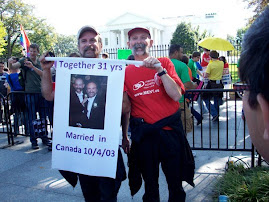ReligiousLeft.us: Marriage (conjugal)
Same-sex marriage through the Ages
Many would have us believe marriage is an unchanged stable foundation of society. Perhaps we should look at marriage a bit closer.
The first *institutional* codes for marriage were written in the Hammurabi Code (1795 – 1750 BC).
The idea of 'romantic' love leading to marriage is a recent creation of Western civilization. Previously marriage was a matter of economics.
American Puritan families were living off the land and self-sufficient. Parents kept control over their children, not only by handing down the family craft and source of income, but by dowries and inheritance of the family lands. Kinship ties through intermarriage between first cousins and even between brothers and sisters were used to cement political and economic relationships. [link]
The first recorded use of the word "marriage" for same-sex couples occurs during the Roman Empire. A number of marriages are recorded to have taken place during this period. The rise of Christianity changed attitudes to same-sex unions and led to the persecution of gays. In the year 342, the Christian emperors Constantius and Constans declared that same-sex marriage to be illegal. In the year 390, the Christian emperors Valentinian II, Theodoisus and Arcadius declared homosexual sex to be illegal and those who were guilty of it were condemned to be burned alive in front of the public. [link]
There appeared to be many marriages taking place without witness or ceremony in the 1500's. The Council of Trent was so disturbed by this, that they decreed (in 1563) that marriages should be celebrated in the presence of a priest and at least two witnesses. Marriage took on a new role of saving men and women from being sinful, as well as the role of procreation. Love wasn't a necessary ingredient for marriage during this era. [link] [link] [link]
In Catholicism, the Council of Trent made the validity of marriage dependent upon its being performed before an ordained member of the clergy and two witnesses. The Council also authorized a Catechism, issued in 1566, which defined marriage as, "The conjugal union of man and woman, contracted between two qualified persons, which obliges them to live together throughout life." [link]
In many jurisdictions, the civil marriage ceremony may take place during the religious marriage ceremony, although they are theoretically and legally distinct. In most American states, the marriage may be officiated by a priest, minister, rabbi or other religious authority, and in such a case the religious authority acts simultaneously as an agent of the state. In some countries, such as France, Spain, Germany, Turkey, Argentina, Japan and Russia, it is necessary to be married by the state separate from (usually before) any religious ceremony, with the state ceremony being the legally binding one. Some states allow civil marriages in circumstances which are not allowed by many religions, such as same-sex marriages or civil unions. [link]
Polygamous marriage, in which a person takes more than one spouse, is accepted in a majority of global social traditions, though it is far less common than monogamy. Africa has the highest rate of polygamy in the world. In Senegal, for example, nearly 47 percent of marriages are multiple. [link]
In 2004, the American Anthropological Association released this statement:
The results of more than a century of anthropological research on households, kinship relationships, and families, across cultures and through time, provide no support whatsoever for the view that either civilization or viable social orders depend upon marriage as an exclusively heterosexual institution. Rather, anthropological research supports the conclusion that a vast array of family types, including families built upon same-sex partnerships, can contribute to stable and humane societies.
Friday, May 23, 2008
ReligiousLeft.us: Marriage (conjugal)
Subscribe to:
Post Comments (Atom)


No comments:
Post a Comment